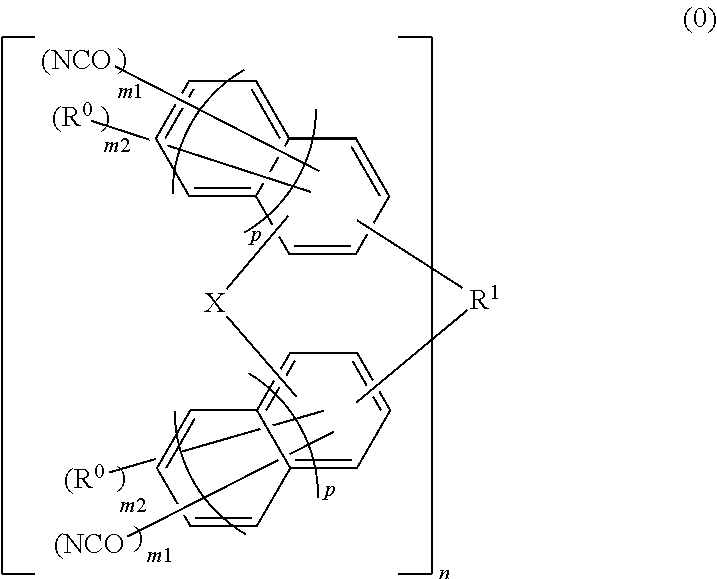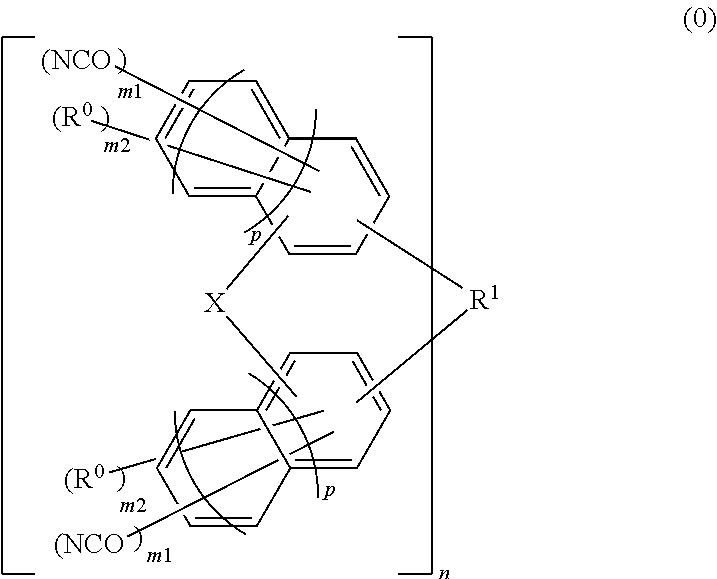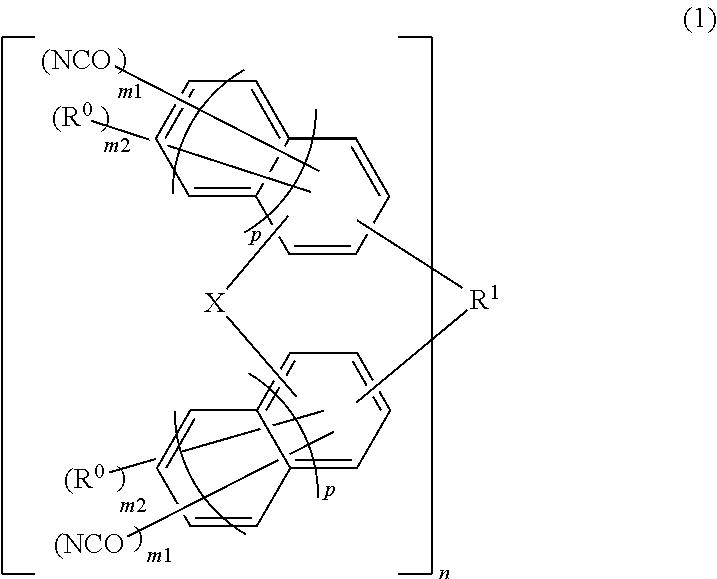Material for forming underlayer film for lithography, composition for forming underlayer film for lithography, underlayer film for lithography and pattern forming method
a technology of lithography and composition, applied in the direction of photosensitive material processing, photomechanical equipment, instruments, etc., can solve the problems of difficult to achieve resist pattern having a film thickness sufficient for processing a substrate, and the intrinsic limitation of light source wavelength, so as to achieve excellent heat resistance and etching resistance
- Summary
- Abstract
- Description
- Claims
- Application Information
AI Technical Summary
Benefits of technology
Problems solved by technology
Method used
Image
Examples
synthesis example 1
Synthesis of bis(4-cyanatophenyl)phenylmethane (Hereinafter, Referred to as “B-CN”.)
[0185]In 100 mL of tetrahydrofuran were 27.6 g (100 mmol) of bis(4-hydroxyphenyl)phenylmethane (produced by Wako Pure Chemical Industries, Ltd.) and 28.3 g (280 mmol) of triethylamine, to provide solution 1.
[0186]Solution 1 was dropped in a mixed liquid of 46.2 g of a solution of 18.4 g (300 mmol) of cyanogen chloride in methylene chloride with 100 mL of tetrahydrofuran at −10° C. over 1.5 hours. Once the termination of the reaction was confirmed, the reaction liquid was concentrated, and the resulting crude product was dissolved in 300 mL of methylene chloride. The resultant was washed with 1 M hydrochloric acid and distilled water, and dried over anhydrous magnesium sulfate. Methylene chloride was distilled off to thereby provide 30.0 g of objective bis(4-cyanatophenyl)phenylmethane. The structure of the compound obtained as described above was identified by NMR spectroscopy.
[0187]The IR spectrum o...
synthesis example 2
Synthesis of tris(4-cyanatophenyl)-1,1,1-methane (Hereinafter, Referred to as “TRPCN”.)
[0190]In 500 g of tetrahydrofuran were 0.17 mol (in terms of OH group) of tris(4-hydroxyphenyl)-1,1,1-methane (produced by Tokyo Chemical Industry Co., Ltd.) and 0.57 mol of triethylamine, to provide solution A. Next, solution A was dropped in a solution, in which 0.67 mol of cyanogen chloride, 175 g of methylene chloride and 500 g of chloroform were mixed, at −5° C. over 1.5 hours and stirred for 30 minutes, and thereafter a mixed solution of 0.08 mol of triethylamine and 15 g of chloroform was dropped therein and further stirred for 30 minutes to terminate the reaction. After the reaction liquid was subjected to filtration, the resulting filtrate was washed with 800 ml of 0.1 N hydrochloric acid, thereafter repeatedly washed with 800 ml of 2.5% brine four times, and finally washed with 800 mL of water. Sodium sulfate was added thereto to remove the water content by adsorption, and thereafter the...
synthesis example 3
Synthesis of Dibenzoxanthene Dcyanate (Hereinafter, Referred to as “BisN-CN”.)
[0194]To a container having an inner volume of 300 ml, equipped with a stirrer, a condenser and a burette, were charged 32.0 g (200 mmol) of 2,6-naphthalenediol (reagent produced by Sigma-Aldrich), 18.2 g (100 mmol) of 4-biphenylaldehyde (produced by Mitsubishi Gas Chemical Company, Inc.) and 100 ml of 1,4-dioxane, 5 ml of 95% sulfuric acid was added thereto, and the reaction liquid was stirred at 100° C. for 6 hours to perform a reaction. Then, the reaction liquid was concentrated, 50 g of pure water was added thereto to precipitate a reaction product, and the resultant was cooled to room temperature followed by filtration for separation. The resulting solid was subjected to filtration, dried, and thereafter separated and purified by column chromatography to thereby provide 30.5 g of an objective compound (BisN-1) represented by the following formula.
[0195]Herein, the following peaks were observed by 400 ...
PUM
| Property | Measurement | Unit |
|---|---|---|
| Length | aaaaa | aaaaa |
| Length | aaaaa | aaaaa |
| Composition | aaaaa | aaaaa |
Abstract
Description
Claims
Application Information
 Login to View More
Login to View More - R&D
- Intellectual Property
- Life Sciences
- Materials
- Tech Scout
- Unparalleled Data Quality
- Higher Quality Content
- 60% Fewer Hallucinations
Browse by: Latest US Patents, China's latest patents, Technical Efficacy Thesaurus, Application Domain, Technology Topic, Popular Technical Reports.
© 2025 PatSnap. All rights reserved.Legal|Privacy policy|Modern Slavery Act Transparency Statement|Sitemap|About US| Contact US: help@patsnap.com



